Cold-weather sailing apparel needs to be more waterproof, more windproof, and much warmer than gear for most other cold-weather activities. To find the best glove for cold-weather sailing, two Practical Sailor testers took 14 pairs with them on a three-season cruise of the Chilean channels. The cold-weather sailing gloves fell into four distinct categories: mid-weight, water-resistant gloves; heavyweight, neoprene gloves; insulated gloves; and layered gloves comprising an outer waterproof shell and an inner glove liner. The test gloves included the Gill Extreme, Gill Dura-shark Winter, Gill Three Seasons, Gill Helmsman, the Henri Lloyd Offshore Racer, Henri Lloyd Stealth Winter, Musto Frostbite, SealSkinz gloves, Stearns Arctic Water, Gul Anatomic Cut Helmsman, Zero Featherlite by Fairfield Line, L.L.Bean Vortex, Lined Nitrile (heavy-duty rubber gloves), and Montanna Hyvent by The North Face.
****
Keeping warm while sailing in freezing temperatures poses a distinct challenge. Most winter sports are active, forcing the body to generate its own heat, and most are done in fairly dry conditions. In sailing, activity comes in short bursts and is often followed by long periods of inactivity-not to mention having to endure to cold, biting winds, and the inevitable wetness.
So, cold-weather sailing apparel needs to be more waterproof, more windproof, and much warmer than gear for most other cold-weather activities. When it comes to gloves, warmth often comes at the expense of dexterity, and sailors need both.

Photos by Beth Leonard
288
Sailors need gloves that are tough and “grippy” enough to handle lines without ripping or slipping; waterproof enough to stay dry if immersed; breathable enough to wick away sweat; and tight enough to not come off when stuck to a frozen surface but loose enough to come off quickly for jobs that require deftness, like knot tying. Thats a tall order for any one type of glove to fill.
Our last, full cold-weather glove test (Practical Sailor, April 15, 2002) found that multi-layer gloves performed the best in the marine environment. The testers top picks included the Gill Helmsman, The North Face Pamir Windstopper, and the neoprene NRS Radiator.
288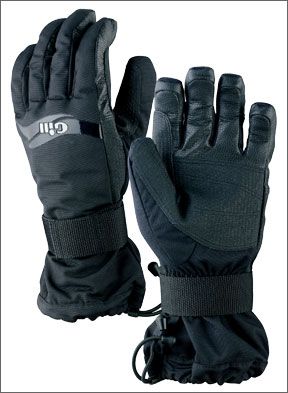
In the March 2008 issue, testers compared two very different types of gloves in winter sailing conditions, the multi-layer North Face Montana HyVent and the neoprene Glacier Gloves. They concluded that both glove types are necessary to deal with the range of conditions sailors face in winter seas.
To see whether any one glove could measure up to the demands of wet, cold-weather sailing, two Practical Sailor testers took more than a dozen pairs with them on a cruise of the Chilean channels. Over the course of six months, temperatures averaged 30 to 40 degrees, and the gloves were subjected to rain, freezing rain, sleet, hail, and snow.
WHAT WE TESTED
Thousands of gloves have been designed for winter sports. Many are marketed as waterproof and could be used as sailing gloves, including the Grandoe ski glove, which did well in the 2002 test.
We narrowed our selection by focusing on gloves recommended by those who have spent a great deal of time on the water in cold weather, including Alaskan fishermen, Antarctic charter skippers, and high-latitude sailors.
The gloves we tested included sailing gloves by Gill, Gul, Henri Lloyd, and Musto; waterproof snowboarding/skiing gloves by L.L.Bean, The North Face, and Zero
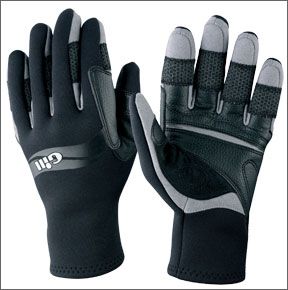
288
Gloves by Fairfield Line; and specialty gloves recommended by experienced cold-weather sailors. This latter group comprised SealSkinz, a waterproof glove made by Danalco and originally designed for kayaking; Stearns Arctic Water gloves, designed for winter diving; and lined “rubber” (PVC, nitrile, or latex) gloves designed for industrial applications, particularly in freezers and cold-storage areas. We ended up with 14 different pairs of gloves from 10 different makers.
As we tested and compared the gloves, it became apparent that they fell into four distinct categories: mid-weight, water-resistant gloves; heavyweight, neoprene gloves; insulated gloves; and layered gloves comprising an outer waterproof shell and an inner glove liner. Each of these categories proved best suited to certain conditions.
Testers wore the gloves in a range of weather conditions and during typical cruising activities. The gloves also were put through a series of bench tests. For more on the test protocol, see “How We Tested,” above.
Mid-Weight, Water-Resistant Gloves
Neoprene depends upon the layer of water between the body and the material to insulate. But when used above the waters surface-and not filled with water-
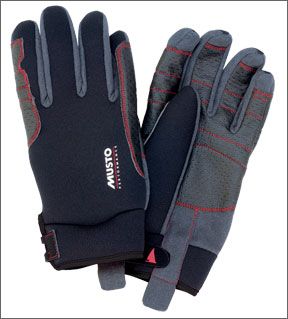
288
neoprene gloves tend to let wind cut through them. Just a thin layer of moisture from leaks or sweat chills hands unless the material is extremely thick. The gloves in this category are made from mid-weight waterproof materials (1.5-millimeter neoprene or similar), and most incorporate other materials in the palm and fingers for increased grip. These secondary materials are not waterproof.
The thinner material provides more dexterity but less warmth than other types of gloves. The relatively short cuffs are designed to go under foul-weather jacket cuffs; this helps prevent water entering the glove.
In general, this category offers dexterity at the expense of warmth and water resistance (above the waters surface). In our opinion, these are best suited for sailing in dry weather in temperatures above 40 degrees.
Gill Extreme: With a leather-like palm and contoured fit, the Extreme is the only neoprene glove we tested with a hydrophobic insulation. This reduces dampness from sweating, making it significantly warmer and more comfortable than other neoprene gloves in dry conditions. However, water soaks through the palm in minutes when handling wet lines or after 20 minutes or so in moderate rain. Once wet, the gloves offer little warmth in temperatures below 50 degrees.
Gill Three Seasons: Made from 1.5-mil neoprene with grippy material on the palm
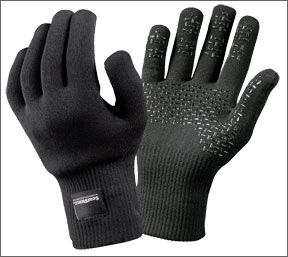
288
and seamless, wraparound Amara on the fingers, the Three Seasons offers the best grip in this category. However, these are less water resistant than the Extreme, and though theyre supposed to be “warm even when wet,” testers reported that their hands quickly grew cold and lost dexterity in 45- to 50-degree temps.
Musto Frostbite: The backs of the Musto gloves are double-sided neoprene, and the palms are imitation leather. Pull-on straps and the wrist closures allow the gloves to slip on or off easily. Although they are marketed for frostbiting, the gloves were the least warm and least water resistant in this category, in our opinion. Testers also questioned their durability and construction quality as the wrist closure gave out in the first use and seams showed signs of wear after a couple of uses.
SealSkinz: Made from a three-layer, patented “breathable” fabric dubbed Waterproof Moisture Vapor Transportation, these gloves did not meet their marketing claims, in our opinion. Hands get sweaty, and the SealSkinz eventually wet through-after an hour or so in a downpour and in less time as the gloves aged. Unlike traditional sailing gloves, these do not have wrist closures, nor do they fit as snugly as neoprene gloves. The “gripper dots” on the palm provide reasonable traction and stand up well to line handling. These gloves are the most water
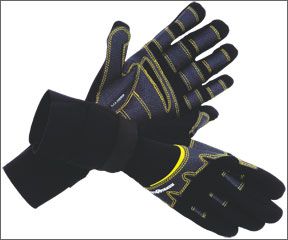
288
resistant in this category, but they did not pass our immersion test.
Bottom line: The Gill Extreme gloves are the warmest and driest in this test category, and we would recommend them for cool-weather (40 to 55 degrees) keelboat or dinghy sailing in splashy conditions. While SealSkinz did not live up to their billing, they worked well as an inner glove under a windproof/waterproof shell in more extreme conditions.
Heavyweight Neoprene Gloves
The gloves in this category are heavyweight neoprene, which makes them significantly warmer than those in the mid-weight category, but with less dexterity. Some have long cuffs meant to go under foul-weather gear or drysuits, but these can make quick removal somewhat difficult. Thick neoprene construction also means that none of the gloves are breathable. The upside to neoprene construction should be a totally waterproof glove, but only two in this group passed immersion testing.
Despite their shortcomings, they are the only solution for extreme cold-water diving and one of the few options when freezing water continuously washes over the decks.
Gill Neoprene Winter: Made from a 3-mil neoprene, these gloves have a double-
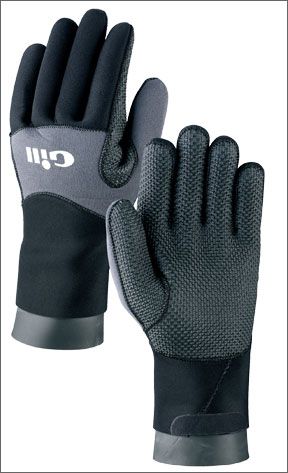
288
cuff system to create a watertight seal and material on the palms for better grip. One layer is to be worn under the cuff of a jacket or a wetsuit and the other to be worn over. This is easier to get on and off than those with higher cuffs and Velcro closures like the Stearns Arctic Water and Henri Lloyd Stealth Winter gloves. However, these gloves did not do well in the immersion test, wetting through in less than a minute.
Henri Lloyd Offshore Racer: Made from 5-mil, double-sided neoprene, these gloves are stitched and glued for maximum water resistance and have a double-cuff similar to the Gill Winter gloves. The near seamless construction and studded palm make the Offshore Racer truly waterproof, and the thick, double-sided neoprene makes them the warmest of the group, in our opinion. The dexterity is about as good as it gets with thick neoprene, allowing the tester to steer, work a winch, and handle lines without removing the gloves. When additional dexterity is required, the gloves come off and go back on more easily than any others in this group.
Henri Lloyd Stealth Winter: Made from a 3-mil neoprene with imitation leather MaxGrip on the palms and fingers, these gloves have a high inner cuff with a tight outer cuff and a Velcro closure that is watertight. These gloves failed the immersion test, wetting through after several minutes along one of the seams between the neoprene and the MaxGrip.
Stearns Arctic Water: These neoprene-only (2.5-mil Dura Mesh) gloves have an adjustable wrist strap and pre-curved finger design. Their seams are glued and
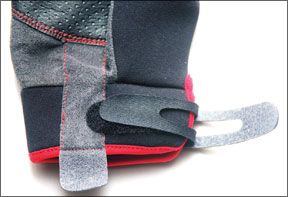
288
blind-stitched, making them totally waterproof. A bit thinner than others in this group, the Stearns have more dexterity than the HL Offshore Racer but sacrifice some warmth. With nothing added to the palm or fingers, these offer the least grip when handling lines and likely would wear out more quickly than others in this group, in our opinion. But they are also among the least expensive and the driest of those tested.
Bottom line: The Henri Lloyd Offshore Racer gloves are the warmest and among the driest in this group. These are the go-to gloves when the decks are awash in freezing water or when cold-water diving. The Stearns Arctic Water Neoprene Gloves are a Budget Buy.
Insulated Gloves
The gloves in this category are made of a windproof, waterproof outer layer over insulation with a breathable, water-resistant insert. The insulating layer adds warmth but takes away dexterity. Two of these gloves performed exceptionally well in the immersion test-hands stayed warm and dry though the insulating layer got soaked when the glove was completely immersed.
In general, this group offers water resistance, breathability, and warmth but loses points for dexterity. These gloves are best-suited to cold- and wet-weather keelboat cruising in temperatures around freezing.
Gill Helmsman: Testers had two versions of these gloves aboard during testing,

288
the older of which was purchased in 2001 and used extensively in Patagonia over two seasons. (This was the same as the model tested in our 2002 review.)
Since then, Gill has made some significant improvements: The newer glove has more insulation and a more water-resistant, more breathable liner. The difference in dexterity was minimal, testers noted. The wide cuff allows the glove to go smoothly over jacket sleeves, and the drawstring on the cuff and the wrist strap can be snugged to prevent water dripping into the gloves. The wicking inner lining makes it easy to get the gloves on and off, even with wet hands. These gloves passed the immersion test, proving to be warm, dry, and comfortable, with excellent grip and sufficient dexterity for all but fine-finger tasks.
Gul Anatomic Fit Helmsman: Made with a breathable nylon outer shell, quick-dry fleece inner liner, and breathable liner membrane, the Gul Helmsman have less insulation but more dexterity than others in this category. The “anatomic fit” and pre-curved fingers make the gloves less bulky than any other insulated glove tested. The cuffs adjustable outer closure made donning and doffing fairly easy. A synthetic leather palm increases grip. However, testers reported that the Gul Helmsman lacked water resistance, soaking through after a half-hour of hard rain, and then losing warmth.
Zero Featherlite by Fairfield Line: Made by an Iowa company specializing in skiing and snowboarding gloves, the Zero Featherlite have a windproof outer Taslan body with polyester insulation and a water-resistant, non-removable, breathable insert.

Photos by Beth Leonard
288
0)]The gloves have a special pocket in the palm for instant-heat packets to be inserted.
The Zeros had the same type of cuff arrangement and tested as well as the Gill Helmsman in the immersion test. Damp hands stick to the Bemberg lining, making it hard to get properly sized gloves on and occasionally causing them to invert when taken off-leading to the laborious process of getting the lining back into the glove. The insulation makes the gloves bulky. Testers could do little more than hand steer with them on, yet they were the warmest gloves in the lineup.
Bottom line: The Gill Helmsman gloves do almost everything well, and they are our pick from this category for sailing in near-freezing waters on keel boats. For those who care only about warmth, we recommend the Zero Featherlites with hand-warmer inserts.
Layered Gloves
Both heavyweight neoprene and insulated gloves need to be removed for any task that requires a bit of deftness, which means our testers spent a lot of time pulling them off and putting them back on. The gloves in this final category solve the trade-off between warmth and dexterity by incorporating two sets of gloves worn in layers.
The outer shell provides insulation and water resistance, but it can be quickly removed when more dexterity is required. The inner layer keeps hands warm for those brief periods when more delicate tasks need to be performed. We found that the standard fleece or polypropylene glove liner soaks through in a matter of seconds when handling saturated lines or working a wet winch handle.
In general, the two-part solution offers the best combination of warmth, water

Photos by Beth Leonard
288
1)]resistance, and dexterity, so it is not surprising that fishermen and professional charter crews working in near-freezing conditions highly recommend the least expensive of these. Layered gloves are best suited to cold, wet weather sailing and to ice fishing.
L.L.Bean Vortex: After testing these for several months, Practical Sailor found out through the manufacturer that the Vortex are being discontinued. Some retailers still have these in stock, but availability is limited. They are being replaced by the Ascent, a new 3-in-1 glove with a Primaloft shell.
The Vortex have an insulated nylon shell, a waterproof Gore-Tex liner, and a separate Gore-Tex windstopper inner liner. The bulky outer shell must be removed for most tasks, but the inner liner provides almost as much dexterity as bare hands. The liner, warm enough in temperatures over 50 degrees, was perfect during brief exposure to the elements. The large cuffs on the shell went over foul-weather gear easily, and the cuff drawstrings kept water from entering the gloves.
Lined Nitrile: An informal survey of Bering Sea fishermen and Antarctica charter captains found that they mostly use lined, “rubber” gloves made from PVC, latex, or nitrile. The Atlas line of sailing gloves-popular with Olympic class and skiff sailors-offers a similar solution: model 495, the Hot Tamales with Removable Liner. These have an abrasion-resistant PVC shell and a separate fabric glove liner.
The gloves we tested-purchased in a local hardware store for $8-were made from heavy nitrile, about twice the thickness of a heavy-duty latex kitchen gloves. The thin cotton lining absorbs moisture when hands sweat. Thin enough to allow some dexterity even with the outer glove on, these still had to be removed for fine-finger work. Testers used these in conjunction with several different glove liners-depending on the temperature-including The North Face Powerstretch, L.L.Bean Windbloc, and in the wettest conditions, the L.L.Bean Vortex Gore-Tex liners and the SealSkinz.
Dexterity depends upon the thickness of the liner, but testers found it to be better

Photos by Beth Leonard
288
2)]than with any of the heavyweight neoprene or insulated glove options. Most of these heavy-duty “rubber” gloves, with large cuffs meant to go over other outerwear, are easy to pull off when greater dexterity is required. There is, however, no closure at the wrist.
The lined nitrile gloves are inexpensive, waterproof, and, with the addition of an appropriate waterproof liner, warm. They are quite rugged and became the testers gloves of choice for line handling, which led to some minor ripping in the gloves nonskid coating, but they are cheap enough that most crews carry multiple pairs and discard them as they wear out.
The North Face Montana HyVent: The waterproof version of the gloves Practical Sailor reviewed in March 2008, these were the costliest pair of gloves tested. They are similar to the L.L.Bean Vortex shell with a waterproof/breathable insert, insulation, and a tough outer material. The 120 grams of pile-fleece insulation was more than the L.L.Bean gloves, making The North Face warmer but also more cumbersome. A liner does not come with this glove; it must be purchased separately, and The North Face does not offer a waterproof liner.
The Polartec Powerstretch liners we tested were very comfortable and allowed excellent dexterity, but they soaked through with any exposure to damp lines or rain. They also increased the price of the gloves to $85 with no real advantages

Photos by Beth Leonard
288
3)]over the other glove choices.
Bottom line: The lined rubber gloves may not be “yachtie,” but they offer just about everything testers were looking for at the lowest price of any other glove tested. Their low cost makes them “disposable,” so they can be used for the tough tasks that tear up other gloves, like handling shore lines. We recommend these for anyone working on the water in near-freezing conditions where they are likely to get wet more than occasionally. The Atlas model 495 PVC glove with a removable fabric liner is already popular with serious winter dinghy sailors.
CONCLUSIONS
When it comes to winter cruising and offshore sailing, we have yet to find the one pair of gloves that can do it all. The range of conditions-from chilly to freezing, from dry to soaking-and the conflict between warmth and dexterity mean that most winter sailors carry a variety of gloves and select the ones that best match the conditions.
The L.L.Bean Vortex came the closest to a one-glove-does-it-all solution, but as it is being discontinued, we tapped the Gill Helmsman as the Practical Sailor Best Choice for cold-weather sailing gloves. The Gill Helmsman, an upgrade to the winning gloves from our previous test, fall short only in not having a removable inner liner.
For tough or messy jobs, wed put the fancy gloves away and pull out the inexpensive, lined rubber gloves. We recommend using these with a liner, preferably waterproof and as warm as necessary. Thin, waterproof glove liners are hard to come by, so we recommend trying the SealSkinz glove as a liner.
As far as neoprene gloves, we recommend the Henri Lloyd Offshore Racer for when immersion is unavoidable. And although they don’t offer any added grip, the Stearns gloves qualify as a Budget Buy neoprene glove.
Our testers will continue to put these gloves to work in the real world and to look for other, better solutions. We welcome feedback from those of you who have your own solutions to keeping hands warm and dry during wet, cold-weather sailing.








































Check out the new SHOWA 281 & 282 TEMRES, especially the new model that is black with a cuff. Waterproof and Breathable! Good for cold and wet, enough dexterity to hold a line or run a winch. Only issue is the sizing is wonky as they are for the Japanese market. However, they are ~$25, so I just bought a few sizes (I’m 5’9 160lbs and wear an XL apparently). There is a distributor in Seattle that sells them online. Just wear any normal glove liner under them, work well. On a long wet sail I swap out the glove liners periodically which inevitably get wet somehow, usually operator error (took my gloves off for a minute to clean my glasses as a wave hit us). Some good videos on YouTube of them transpiring water vapor from inside to outside of the glove, actually drying your hands out out over time.
I live in the Pacific Northwest and use the Alaskan Nitrile lined fishing gloves. Have for thirty years. You can handle lines with them just fine. The only thing you cant do is open shackles and check your cell phone. If you go to any store in SE Alaska you only find these kinds of gloves and tons of equally (none sailing) low tech boots. No fancy sailing gear there as they use only what works and provides good value.
Very useful article, Thanks. I could not find the “Zero Featherlite by Fairfield Line” online. The closest I could find was:
https://www.ebay.com/itm/255168114033?_trkparms=amclksrc%3DITM%26aid%3D1110006%26algo%3DHOMESPLICE.SIM%26ao%3D1%26asc%3D20200818143230%26meid%3D25ada4c4851b4102b8a7fa374350440b%26pid%3D101224%26rk%3D1%26rkt%3D5%26sd%3D255168179933%26itm%3D255168114033%26pmt%3D1%26noa%3D1%26pg%3D2047675%26algv%3DDefaultOrganicWeb%26brand%3DFairfield+Plate&_trksid=p2047675.c101224.m-1
and these:
https://www.ebay.com/itm/332385092854
and having no pictures to guide my search I gave up. I do like and ordered the Atlas Model 495 especially since it is a favorite of pros in a cold marine environment. Thanks again, Capt Jerry